FAAR5019 Financial Report: Ratio Analysis of Next Plc
VerifiedAdded on 2023/05/29
|15
|3085
|470
Report
AI Summary
This report analyzes the financial performance of Next Plc using ratio analysis, covering working capital, liquidity, profitability, and investor ratios. It also discusses the merits and demerits of Limited Liability Companies (LLC) compared to sole proprietorships and partnerships, highlighting the advantages and disadvantages of the LLC structure, including taxation, organizational flexibility, and transfer of ownership. The analysis includes a review of Next Plc's financial data from 2014 to 2018, examining trends in receivable days, inventory days, current ratio, quick ratio, net profit margin, return on capital employed, earnings per share (EPS), and dividend per share (DPS) to assess the company's financial health and market position. Desklib offers a variety of resources including solved assignments and past papers to aid students in their studies.
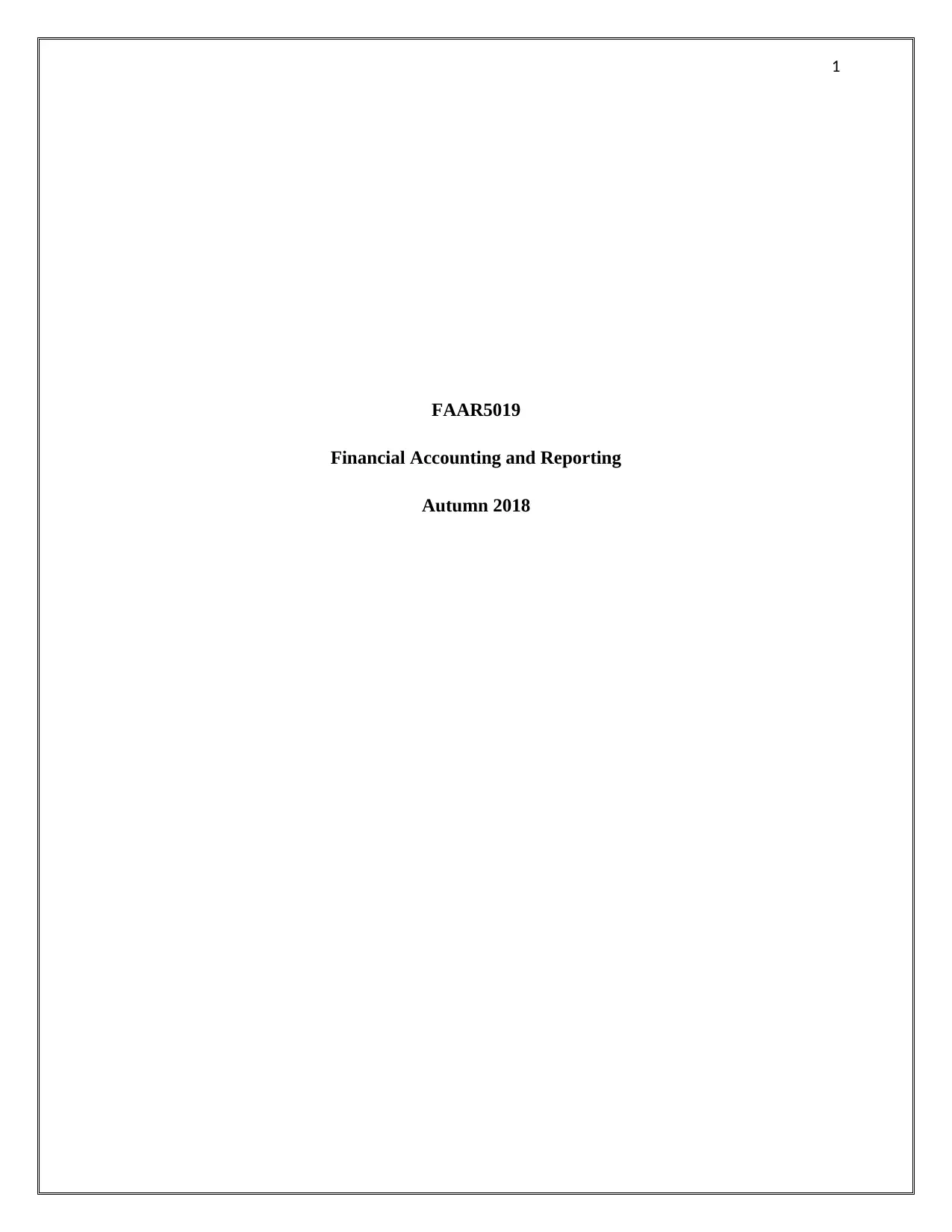
1
FAAR5019
Financial Accounting and Reporting
Autumn 2018
FAAR5019
Financial Accounting and Reporting
Autumn 2018
Paraphrase This Document
Need a fresh take? Get an instant paraphrase of this document with our AI Paraphraser
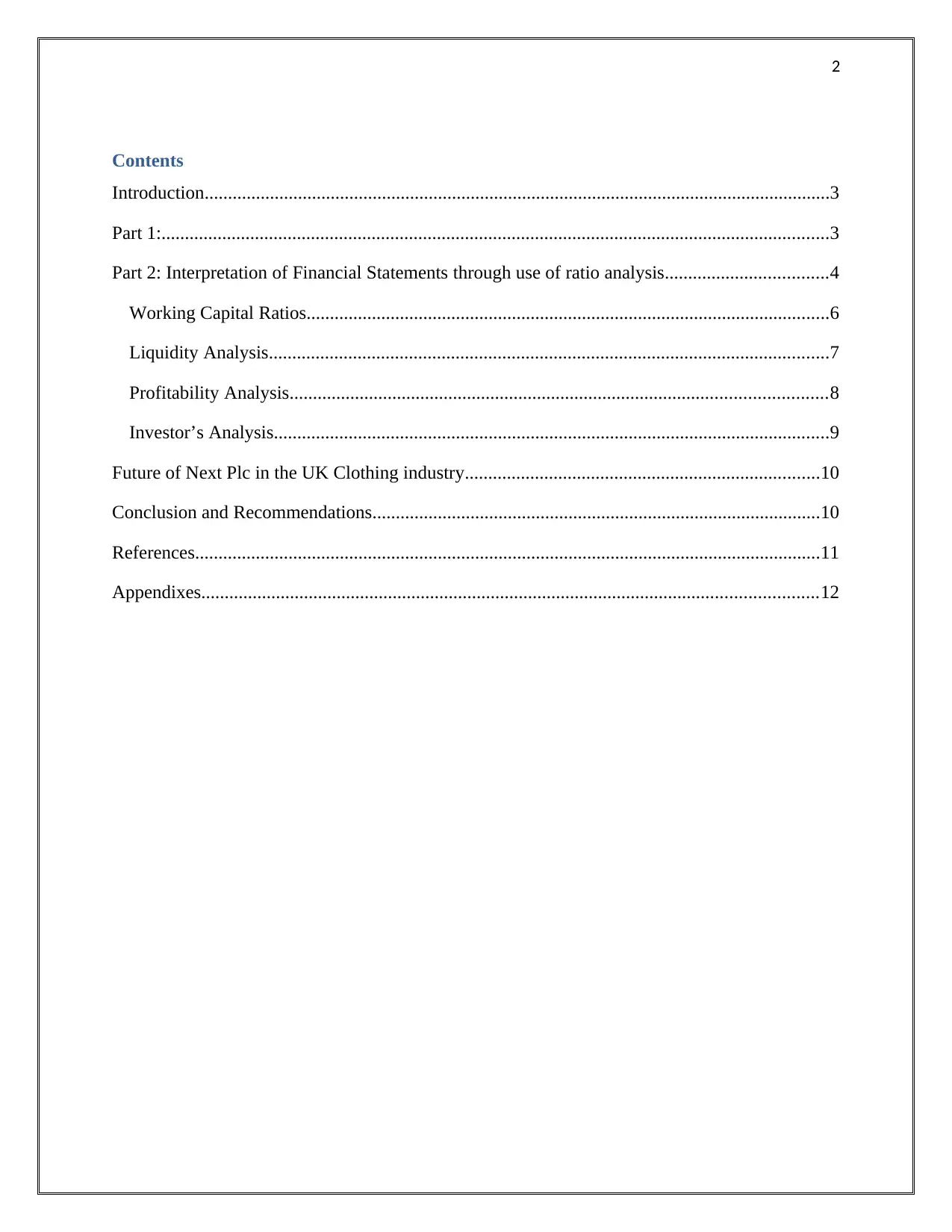
2
Contents
Introduction......................................................................................................................................3
Part 1:...............................................................................................................................................3
Part 2: Interpretation of Financial Statements through use of ratio analysis...................................4
Working Capital Ratios................................................................................................................6
Liquidity Analysis........................................................................................................................7
Profitability Analysis...................................................................................................................8
Investor’s Analysis.......................................................................................................................9
Future of Next Plc in the UK Clothing industry............................................................................10
Conclusion and Recommendations................................................................................................10
References......................................................................................................................................11
Appendixes....................................................................................................................................12
Contents
Introduction......................................................................................................................................3
Part 1:...............................................................................................................................................3
Part 2: Interpretation of Financial Statements through use of ratio analysis...................................4
Working Capital Ratios................................................................................................................6
Liquidity Analysis........................................................................................................................7
Profitability Analysis...................................................................................................................8
Investor’s Analysis.......................................................................................................................9
Future of Next Plc in the UK Clothing industry............................................................................10
Conclusion and Recommendations................................................................................................10
References......................................................................................................................................11
Appendixes....................................................................................................................................12

3
Introduction
The present report is developed for developing an understanding of the specific aspects of
the operations of Limited Liability Company (LLC). In this context, it has discussed the merits
and demerits of the LLC in comparison to the business structure of sole proprietorship and
partnership. This is followed by demonstrating an understanding of the financial statements of a
LLC, that is, Next Plc through the use of ratio analysis. The ratio analysis carries out an
examination of the working capital, liquidity, profitability and investor ratios of the company.
Part 1:
Limited Liability Company (LLC) can be regarded as a corporate structure in which the
members of the company do not possess any personal liability for meeting its financial debts or
liabilities. They can be regarded as hybrid entities that integrate the characteristics of both
corporation and sole proprietorship. LLC possess the business structure of both partnership of
sole proprietorship but a limited liability of a corporation. As such, in this type of businesses
there is distinction between the business assets from the personal assets of the owners and as
such they are not responsible for meeting their debt or liabilities. LLC is not regarded as a
separate entity and as such the company is not required to pay any taxes or being responsible for
any type of financial losses (Mancuso, 2016).
The major merit of the LCC in comparison to other business forms that are sole
proprietorship and partnership can be stated as follows:
It is not subjected to higher types of financial regulations in comparison to the sole
proprietorship and partnership. As such, it facilitates the management for developing
flexible organizational structure in comparison to other business forms.
There is no requirement for filling a corporate tax return as the owners report their share
of profit and losses on the tax returns that enables the firms to avoid double taxation.
The ownership in the case of Limited Liability Company can be easily transferred to a
third party without having any impact on the business operations. On the other hand, the
ownership transfer in the case of sole proprietorship or partnership is a complex process
that requires that each of its assets, licenses or permits need to be individually transferred.
Introduction
The present report is developed for developing an understanding of the specific aspects of
the operations of Limited Liability Company (LLC). In this context, it has discussed the merits
and demerits of the LLC in comparison to the business structure of sole proprietorship and
partnership. This is followed by demonstrating an understanding of the financial statements of a
LLC, that is, Next Plc through the use of ratio analysis. The ratio analysis carries out an
examination of the working capital, liquidity, profitability and investor ratios of the company.
Part 1:
Limited Liability Company (LLC) can be regarded as a corporate structure in which the
members of the company do not possess any personal liability for meeting its financial debts or
liabilities. They can be regarded as hybrid entities that integrate the characteristics of both
corporation and sole proprietorship. LLC possess the business structure of both partnership of
sole proprietorship but a limited liability of a corporation. As such, in this type of businesses
there is distinction between the business assets from the personal assets of the owners and as
such they are not responsible for meeting their debt or liabilities. LLC is not regarded as a
separate entity and as such the company is not required to pay any taxes or being responsible for
any type of financial losses (Mancuso, 2016).
The major merit of the LCC in comparison to other business forms that are sole
proprietorship and partnership can be stated as follows:
It is not subjected to higher types of financial regulations in comparison to the sole
proprietorship and partnership. As such, it facilitates the management for developing
flexible organizational structure in comparison to other business forms.
There is no requirement for filling a corporate tax return as the owners report their share
of profit and losses on the tax returns that enables the firms to avoid double taxation.
The ownership in the case of Limited Liability Company can be easily transferred to a
third party without having any impact on the business operations. On the other hand, the
ownership transfer in the case of sole proprietorship or partnership is a complex process
that requires that each of its assets, licenses or permits need to be individually transferred.
⊘ This is a preview!⊘
Do you want full access?
Subscribe today to unlock all pages.

Trusted by 1+ million students worldwide

4
It is also attributed to be least expensive form of company structure to be established in
comparison to other business firms
Also, the business in the case of limited liability company can be easily dissolved in
comparison to other types of business structure
The owners are in complete control of the business and can take decisions that they think
to be adequate (Cody, 2007)
The demerits of the LLC business structure are stated as follows:
The major drawback of establishing a LLC in comparison to the business forms of sole
proprietorship or partnership is that it incurs higher cost for its initial establishment. The
cost is incurred in the form of initial formation fees and filling fees
There is a lot of paperwork requires foe establishing a LLC in comparison to other types
of business firms. The sole proprietorship or partnership can be established without
having any formal organizing procedures.
It is required for the owners of the LLC to maintain separate records for maintaining their
liability protection. They are requires to keep personal affairs in distinction with the main
business and this is often a very complex process requiring huge time and money
The owners of a LLC does not possess any authority for issuing shares in order to realize
funds from the investors (Martin, 2010)
Part 2: Interpretation of Financial Statements through use of ratio analysis
In this section of the report, interpretation of financial statement of Next Plc has been
done for last five years. In order to perform the interpretation of financial statement of Next plc,
ratio analysis has been used and this analysis covers working capital ratios, liquidity ratios,
profitability ratios and investor’s ratios.
For the purpose of calculation financial data has been collected from the annual reports of
Next Plc for last five years and it has been presented in below table:
Financial Statement data of Next Plc
Financial Data 2014 2015 2016 2017 2018
Trade Receivables £ 808.00 £ 844.30 £ 1,050.50 £ 1,125.80 £
It is also attributed to be least expensive form of company structure to be established in
comparison to other business firms
Also, the business in the case of limited liability company can be easily dissolved in
comparison to other types of business structure
The owners are in complete control of the business and can take decisions that they think
to be adequate (Cody, 2007)
The demerits of the LLC business structure are stated as follows:
The major drawback of establishing a LLC in comparison to the business forms of sole
proprietorship or partnership is that it incurs higher cost for its initial establishment. The
cost is incurred in the form of initial formation fees and filling fees
There is a lot of paperwork requires foe establishing a LLC in comparison to other types
of business firms. The sole proprietorship or partnership can be established without
having any formal organizing procedures.
It is required for the owners of the LLC to maintain separate records for maintaining their
liability protection. They are requires to keep personal affairs in distinction with the main
business and this is often a very complex process requiring huge time and money
The owners of a LLC does not possess any authority for issuing shares in order to realize
funds from the investors (Martin, 2010)
Part 2: Interpretation of Financial Statements through use of ratio analysis
In this section of the report, interpretation of financial statement of Next Plc has been
done for last five years. In order to perform the interpretation of financial statement of Next plc,
ratio analysis has been used and this analysis covers working capital ratios, liquidity ratios,
profitability ratios and investor’s ratios.
For the purpose of calculation financial data has been collected from the annual reports of
Next Plc for last five years and it has been presented in below table:
Financial Statement data of Next Plc
Financial Data 2014 2015 2016 2017 2018
Trade Receivables £ 808.00 £ 844.30 £ 1,050.50 £ 1,125.80 £
Paraphrase This Document
Need a fresh take? Get an instant paraphrase of this document with our AI Paraphraser

5
1,248.20
Sales / Revenue £ 3,740.00 £ 3,999.80 £ 4,176.90 £ 4,097.30
£
4,055.50
Inventory £ 385.60 £ 416.80 £ 486.50 £ 451.10
£
490.10
Cost of Sales £ 2,499.90 £ 2,656.40 £ 2,724.20 £ 2,710.70
£
2,699.30
Current Assets £ 1,468.10 £ 1,616.00 £ 1,642.20 £ 1,660.60
£
1,797.50
Current Liabilities £ 834.50 £ 886.60 £ 1,170.60 £ 725.00
£
914.80
Quick Assets £ 1,082.50 £ 1,199.20 £ 1,155.70 £ 1,209.50
£
1,307.40
Net Profit £ 553.20 £ 634.90 £ 666.80 £ 635.30
£
591.80
Profit before Interest
and tax (EBIT) £ 722.80 £ 812.10 £ 867.20 £ 827.70
£
759.90
Shareholders’ Equity £ 286.20 £ 321.90 £ 311.80 £ 510.50
£
482.60
Non Current Liabilities £ 1,023.90 £ 1,073.80 £ 847.70 £ 1,169.30
£
1,164.10
Net income available
to common
stockholders £ 553.20 £ 634.90 £ 666.80 £ 635.30
£
591.80
No of common shares
outstanding (in
Millions) 151.10 148.30 148.00 144.00 142.00
(Annual Report: Next Plc, 2014), (Annual Report: Next Plc, 2015), (Annual Report: Next Plc,
2016), (Annual Report: Next Plc, 2017) and (Annual Report: Next Plc, 2018)
1,248.20
Sales / Revenue £ 3,740.00 £ 3,999.80 £ 4,176.90 £ 4,097.30
£
4,055.50
Inventory £ 385.60 £ 416.80 £ 486.50 £ 451.10
£
490.10
Cost of Sales £ 2,499.90 £ 2,656.40 £ 2,724.20 £ 2,710.70
£
2,699.30
Current Assets £ 1,468.10 £ 1,616.00 £ 1,642.20 £ 1,660.60
£
1,797.50
Current Liabilities £ 834.50 £ 886.60 £ 1,170.60 £ 725.00
£
914.80
Quick Assets £ 1,082.50 £ 1,199.20 £ 1,155.70 £ 1,209.50
£
1,307.40
Net Profit £ 553.20 £ 634.90 £ 666.80 £ 635.30
£
591.80
Profit before Interest
and tax (EBIT) £ 722.80 £ 812.10 £ 867.20 £ 827.70
£
759.90
Shareholders’ Equity £ 286.20 £ 321.90 £ 311.80 £ 510.50
£
482.60
Non Current Liabilities £ 1,023.90 £ 1,073.80 £ 847.70 £ 1,169.30
£
1,164.10
Net income available
to common
stockholders £ 553.20 £ 634.90 £ 666.80 £ 635.30
£
591.80
No of common shares
outstanding (in
Millions) 151.10 148.30 148.00 144.00 142.00
(Annual Report: Next Plc, 2014), (Annual Report: Next Plc, 2015), (Annual Report: Next Plc,
2016), (Annual Report: Next Plc, 2017) and (Annual Report: Next Plc, 2018)
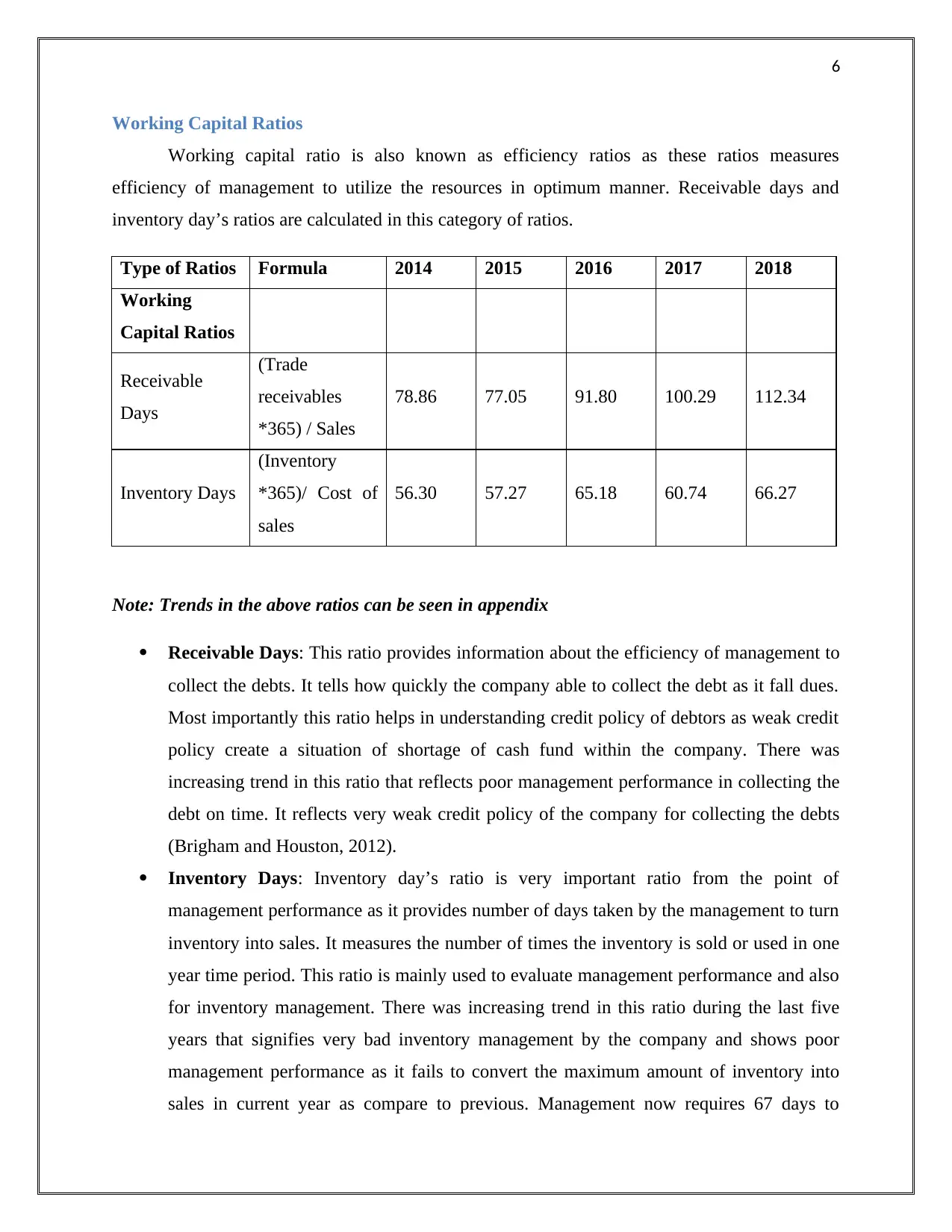
6
Working Capital Ratios
Working capital ratio is also known as efficiency ratios as these ratios measures
efficiency of management to utilize the resources in optimum manner. Receivable days and
inventory day’s ratios are calculated in this category of ratios.
Type of Ratios Formula 2014 2015 2016 2017 2018
Working
Capital Ratios
Receivable
Days
(Trade
receivables
*365) / Sales
78.86 77.05 91.80 100.29 112.34
Inventory Days
(Inventory
*365)/ Cost of
sales
56.30 57.27 65.18 60.74 66.27
Note: Trends in the above ratios can be seen in appendix
Receivable Days: This ratio provides information about the efficiency of management to
collect the debts. It tells how quickly the company able to collect the debt as it fall dues.
Most importantly this ratio helps in understanding credit policy of debtors as weak credit
policy create a situation of shortage of cash fund within the company. There was
increasing trend in this ratio that reflects poor management performance in collecting the
debt on time. It reflects very weak credit policy of the company for collecting the debts
(Brigham and Houston, 2012).
Inventory Days: Inventory day’s ratio is very important ratio from the point of
management performance as it provides number of days taken by the management to turn
inventory into sales. It measures the number of times the inventory is sold or used in one
year time period. This ratio is mainly used to evaluate management performance and also
for inventory management. There was increasing trend in this ratio during the last five
years that signifies very bad inventory management by the company and shows poor
management performance as it fails to convert the maximum amount of inventory into
sales in current year as compare to previous. Management now requires 67 days to
Working Capital Ratios
Working capital ratio is also known as efficiency ratios as these ratios measures
efficiency of management to utilize the resources in optimum manner. Receivable days and
inventory day’s ratios are calculated in this category of ratios.
Type of Ratios Formula 2014 2015 2016 2017 2018
Working
Capital Ratios
Receivable
Days
(Trade
receivables
*365) / Sales
78.86 77.05 91.80 100.29 112.34
Inventory Days
(Inventory
*365)/ Cost of
sales
56.30 57.27 65.18 60.74 66.27
Note: Trends in the above ratios can be seen in appendix
Receivable Days: This ratio provides information about the efficiency of management to
collect the debts. It tells how quickly the company able to collect the debt as it fall dues.
Most importantly this ratio helps in understanding credit policy of debtors as weak credit
policy create a situation of shortage of cash fund within the company. There was
increasing trend in this ratio that reflects poor management performance in collecting the
debt on time. It reflects very weak credit policy of the company for collecting the debts
(Brigham and Houston, 2012).
Inventory Days: Inventory day’s ratio is very important ratio from the point of
management performance as it provides number of days taken by the management to turn
inventory into sales. It measures the number of times the inventory is sold or used in one
year time period. This ratio is mainly used to evaluate management performance and also
for inventory management. There was increasing trend in this ratio during the last five
years that signifies very bad inventory management by the company and shows poor
management performance as it fails to convert the maximum amount of inventory into
sales in current year as compare to previous. Management now requires 67 days to
⊘ This is a preview!⊘
Do you want full access?
Subscribe today to unlock all pages.

Trusted by 1+ million students worldwide
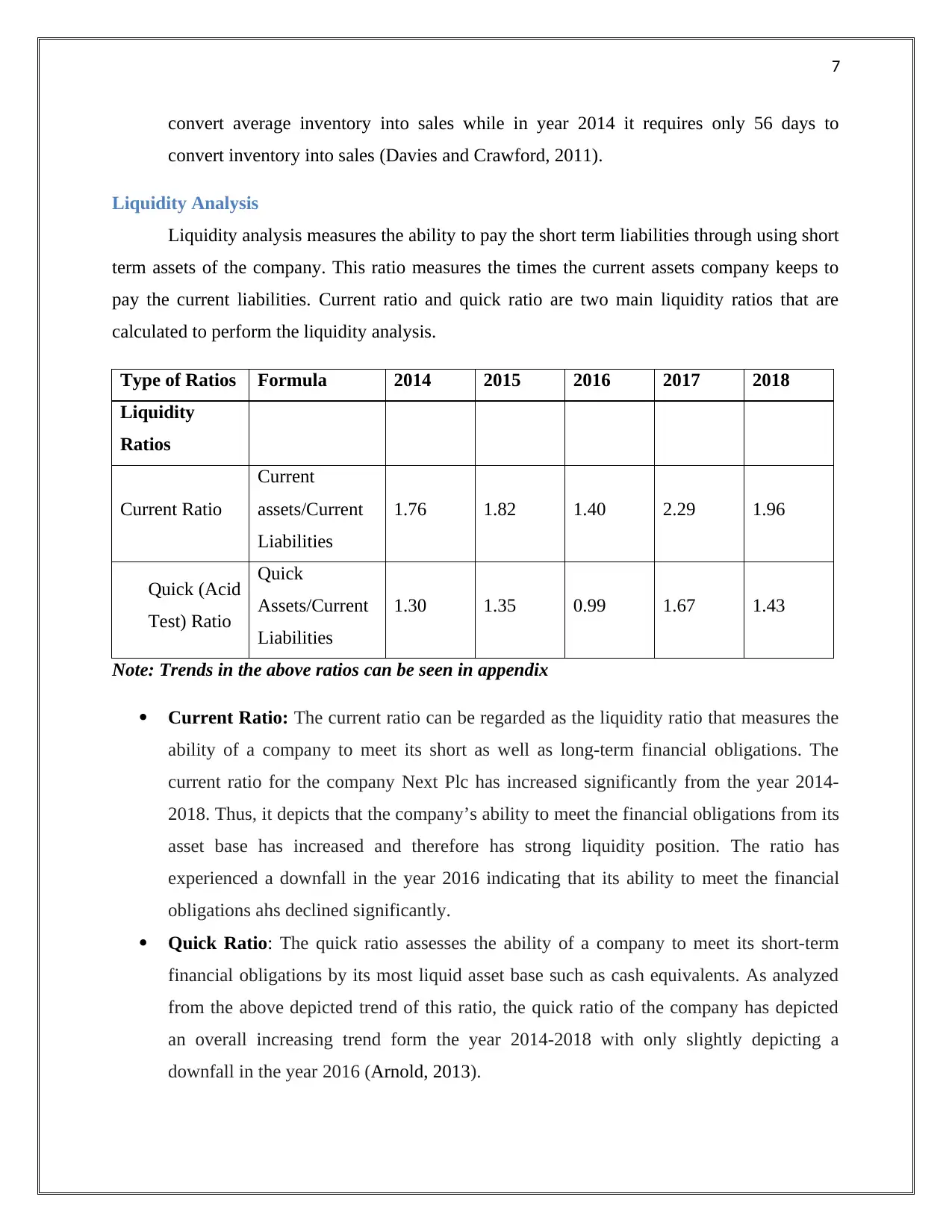
7
convert average inventory into sales while in year 2014 it requires only 56 days to
convert inventory into sales (Davies and Crawford, 2011).
Liquidity Analysis
Liquidity analysis measures the ability to pay the short term liabilities through using short
term assets of the company. This ratio measures the times the current assets company keeps to
pay the current liabilities. Current ratio and quick ratio are two main liquidity ratios that are
calculated to perform the liquidity analysis.
Type of Ratios Formula 2014 2015 2016 2017 2018
Liquidity
Ratios
Current Ratio
Current
assets/Current
Liabilities
1.76 1.82 1.40 2.29 1.96
Quick (Acid
Test) Ratio
Quick
Assets/Current
Liabilities
1.30 1.35 0.99 1.67 1.43
Note: Trends in the above ratios can be seen in appendix
Current Ratio: The current ratio can be regarded as the liquidity ratio that measures the
ability of a company to meet its short as well as long-term financial obligations. The
current ratio for the company Next Plc has increased significantly from the year 2014-
2018. Thus, it depicts that the company’s ability to meet the financial obligations from its
asset base has increased and therefore has strong liquidity position. The ratio has
experienced a downfall in the year 2016 indicating that its ability to meet the financial
obligations ahs declined significantly.
Quick Ratio: The quick ratio assesses the ability of a company to meet its short-term
financial obligations by its most liquid asset base such as cash equivalents. As analyzed
from the above depicted trend of this ratio, the quick ratio of the company has depicted
an overall increasing trend form the year 2014-2018 with only slightly depicting a
downfall in the year 2016 (Arnold, 2013).
convert average inventory into sales while in year 2014 it requires only 56 days to
convert inventory into sales (Davies and Crawford, 2011).
Liquidity Analysis
Liquidity analysis measures the ability to pay the short term liabilities through using short
term assets of the company. This ratio measures the times the current assets company keeps to
pay the current liabilities. Current ratio and quick ratio are two main liquidity ratios that are
calculated to perform the liquidity analysis.
Type of Ratios Formula 2014 2015 2016 2017 2018
Liquidity
Ratios
Current Ratio
Current
assets/Current
Liabilities
1.76 1.82 1.40 2.29 1.96
Quick (Acid
Test) Ratio
Quick
Assets/Current
Liabilities
1.30 1.35 0.99 1.67 1.43
Note: Trends in the above ratios can be seen in appendix
Current Ratio: The current ratio can be regarded as the liquidity ratio that measures the
ability of a company to meet its short as well as long-term financial obligations. The
current ratio for the company Next Plc has increased significantly from the year 2014-
2018. Thus, it depicts that the company’s ability to meet the financial obligations from its
asset base has increased and therefore has strong liquidity position. The ratio has
experienced a downfall in the year 2016 indicating that its ability to meet the financial
obligations ahs declined significantly.
Quick Ratio: The quick ratio assesses the ability of a company to meet its short-term
financial obligations by its most liquid asset base such as cash equivalents. As analyzed
from the above depicted trend of this ratio, the quick ratio of the company has depicted
an overall increasing trend form the year 2014-2018 with only slightly depicting a
downfall in the year 2016 (Arnold, 2013).
Paraphrase This Document
Need a fresh take? Get an instant paraphrase of this document with our AI Paraphraser
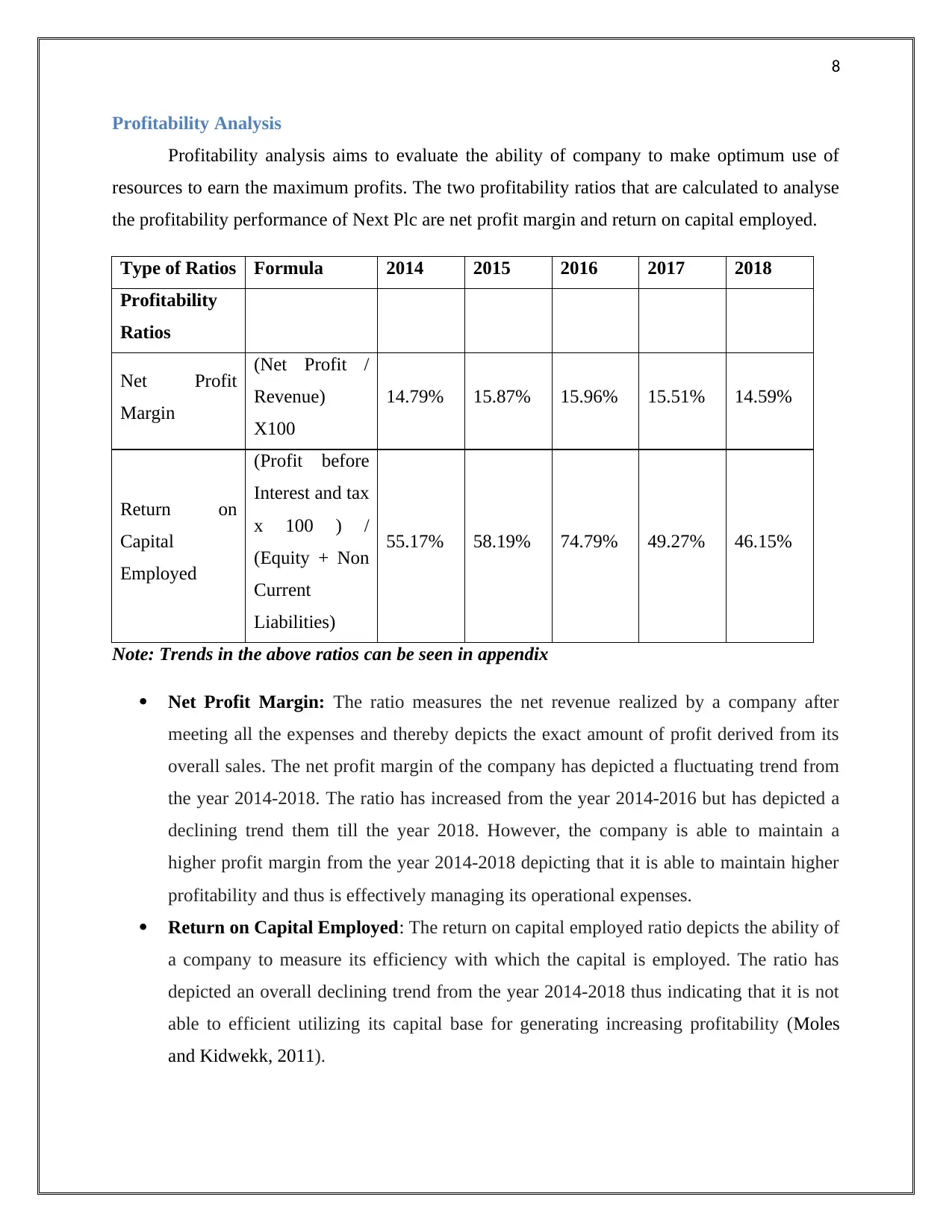
8
Profitability Analysis
Profitability analysis aims to evaluate the ability of company to make optimum use of
resources to earn the maximum profits. The two profitability ratios that are calculated to analyse
the profitability performance of Next Plc are net profit margin and return on capital employed.
Type of Ratios Formula 2014 2015 2016 2017 2018
Profitability
Ratios
Net Profit
Margin
(Net Profit /
Revenue)
X100
14.79% 15.87% 15.96% 15.51% 14.59%
Return on
Capital
Employed
(Profit before
Interest and tax
x 100 ) /
(Equity + Non
Current
Liabilities)
55.17% 58.19% 74.79% 49.27% 46.15%
Note: Trends in the above ratios can be seen in appendix
Net Profit Margin: The ratio measures the net revenue realized by a company after
meeting all the expenses and thereby depicts the exact amount of profit derived from its
overall sales. The net profit margin of the company has depicted a fluctuating trend from
the year 2014-2018. The ratio has increased from the year 2014-2016 but has depicted a
declining trend them till the year 2018. However, the company is able to maintain a
higher profit margin from the year 2014-2018 depicting that it is able to maintain higher
profitability and thus is effectively managing its operational expenses.
Return on Capital Employed: The return on capital employed ratio depicts the ability of
a company to measure its efficiency with which the capital is employed. The ratio has
depicted an overall declining trend from the year 2014-2018 thus indicating that it is not
able to efficient utilizing its capital base for generating increasing profitability (Moles
and Kidwekk, 2011).
Profitability Analysis
Profitability analysis aims to evaluate the ability of company to make optimum use of
resources to earn the maximum profits. The two profitability ratios that are calculated to analyse
the profitability performance of Next Plc are net profit margin and return on capital employed.
Type of Ratios Formula 2014 2015 2016 2017 2018
Profitability
Ratios
Net Profit
Margin
(Net Profit /
Revenue)
X100
14.79% 15.87% 15.96% 15.51% 14.59%
Return on
Capital
Employed
(Profit before
Interest and tax
x 100 ) /
(Equity + Non
Current
Liabilities)
55.17% 58.19% 74.79% 49.27% 46.15%
Note: Trends in the above ratios can be seen in appendix
Net Profit Margin: The ratio measures the net revenue realized by a company after
meeting all the expenses and thereby depicts the exact amount of profit derived from its
overall sales. The net profit margin of the company has depicted a fluctuating trend from
the year 2014-2018. The ratio has increased from the year 2014-2016 but has depicted a
declining trend them till the year 2018. However, the company is able to maintain a
higher profit margin from the year 2014-2018 depicting that it is able to maintain higher
profitability and thus is effectively managing its operational expenses.
Return on Capital Employed: The return on capital employed ratio depicts the ability of
a company to measure its efficiency with which the capital is employed. The ratio has
depicted an overall declining trend from the year 2014-2018 thus indicating that it is not
able to efficient utilizing its capital base for generating increasing profitability (Moles
and Kidwekk, 2011).
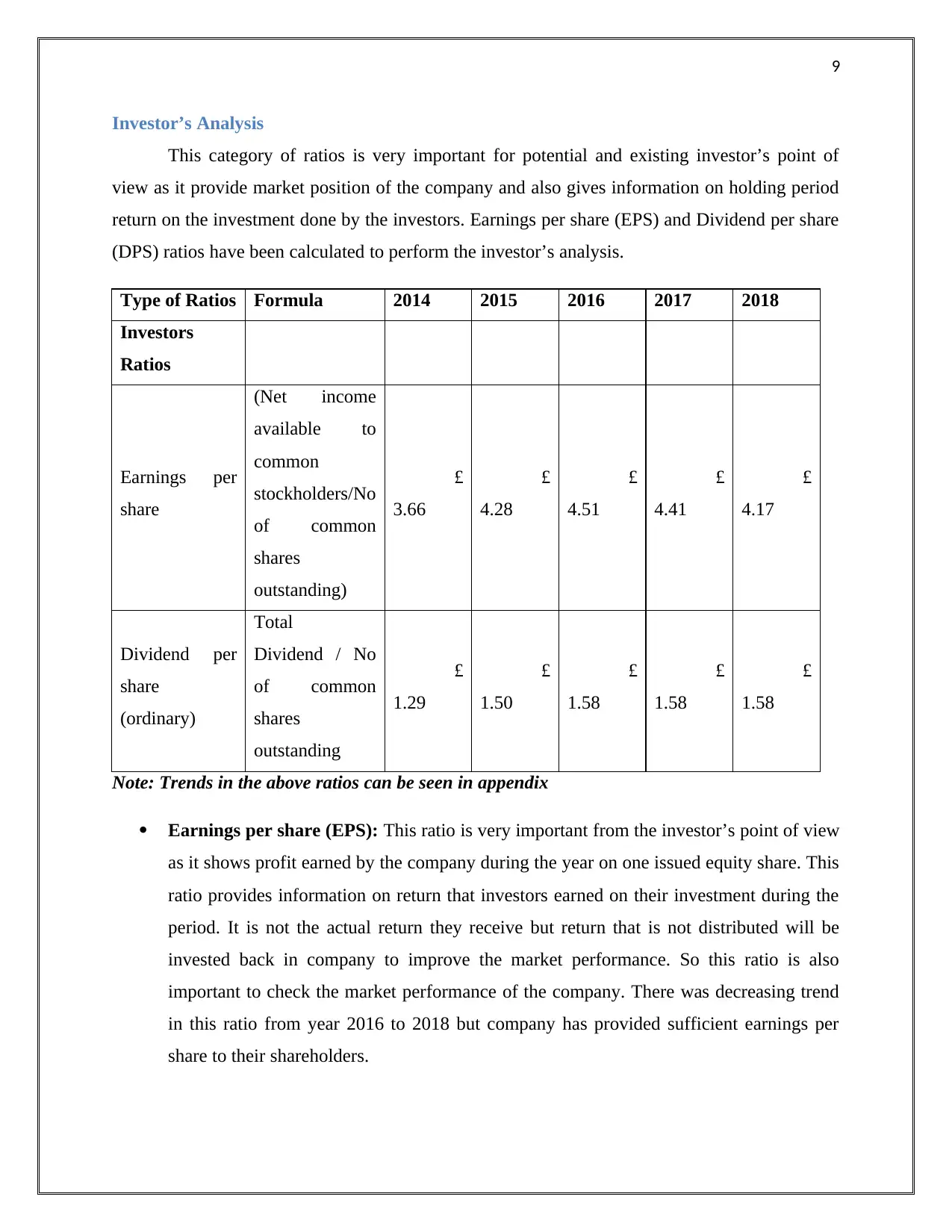
9
Investor’s Analysis
This category of ratios is very important for potential and existing investor’s point of
view as it provide market position of the company and also gives information on holding period
return on the investment done by the investors. Earnings per share (EPS) and Dividend per share
(DPS) ratios have been calculated to perform the investor’s analysis.
Type of Ratios Formula 2014 2015 2016 2017 2018
Investors
Ratios
Earnings per
share
(Net income
available to
common
stockholders/No
of common
shares
outstanding)
£
3.66
£
4.28
£
4.51
£
4.41
£
4.17
Dividend per
share
(ordinary)
Total
Dividend / No
of common
shares
outstanding
£
1.29
£
1.50
£
1.58
£
1.58
£
1.58
Note: Trends in the above ratios can be seen in appendix
Earnings per share (EPS): This ratio is very important from the investor’s point of view
as it shows profit earned by the company during the year on one issued equity share. This
ratio provides information on return that investors earned on their investment during the
period. It is not the actual return they receive but return that is not distributed will be
invested back in company to improve the market performance. So this ratio is also
important to check the market performance of the company. There was decreasing trend
in this ratio from year 2016 to 2018 but company has provided sufficient earnings per
share to their shareholders.
Investor’s Analysis
This category of ratios is very important for potential and existing investor’s point of
view as it provide market position of the company and also gives information on holding period
return on the investment done by the investors. Earnings per share (EPS) and Dividend per share
(DPS) ratios have been calculated to perform the investor’s analysis.
Type of Ratios Formula 2014 2015 2016 2017 2018
Investors
Ratios
Earnings per
share
(Net income
available to
common
stockholders/No
of common
shares
outstanding)
£
3.66
£
4.28
£
4.51
£
4.41
£
4.17
Dividend per
share
(ordinary)
Total
Dividend / No
of common
shares
outstanding
£
1.29
£
1.50
£
1.58
£
1.58
£
1.58
Note: Trends in the above ratios can be seen in appendix
Earnings per share (EPS): This ratio is very important from the investor’s point of view
as it shows profit earned by the company during the year on one issued equity share. This
ratio provides information on return that investors earned on their investment during the
period. It is not the actual return they receive but return that is not distributed will be
invested back in company to improve the market performance. So this ratio is also
important to check the market performance of the company. There was decreasing trend
in this ratio from year 2016 to 2018 but company has provided sufficient earnings per
share to their shareholders.
⊘ This is a preview!⊘
Do you want full access?
Subscribe today to unlock all pages.

Trusted by 1+ million students worldwide
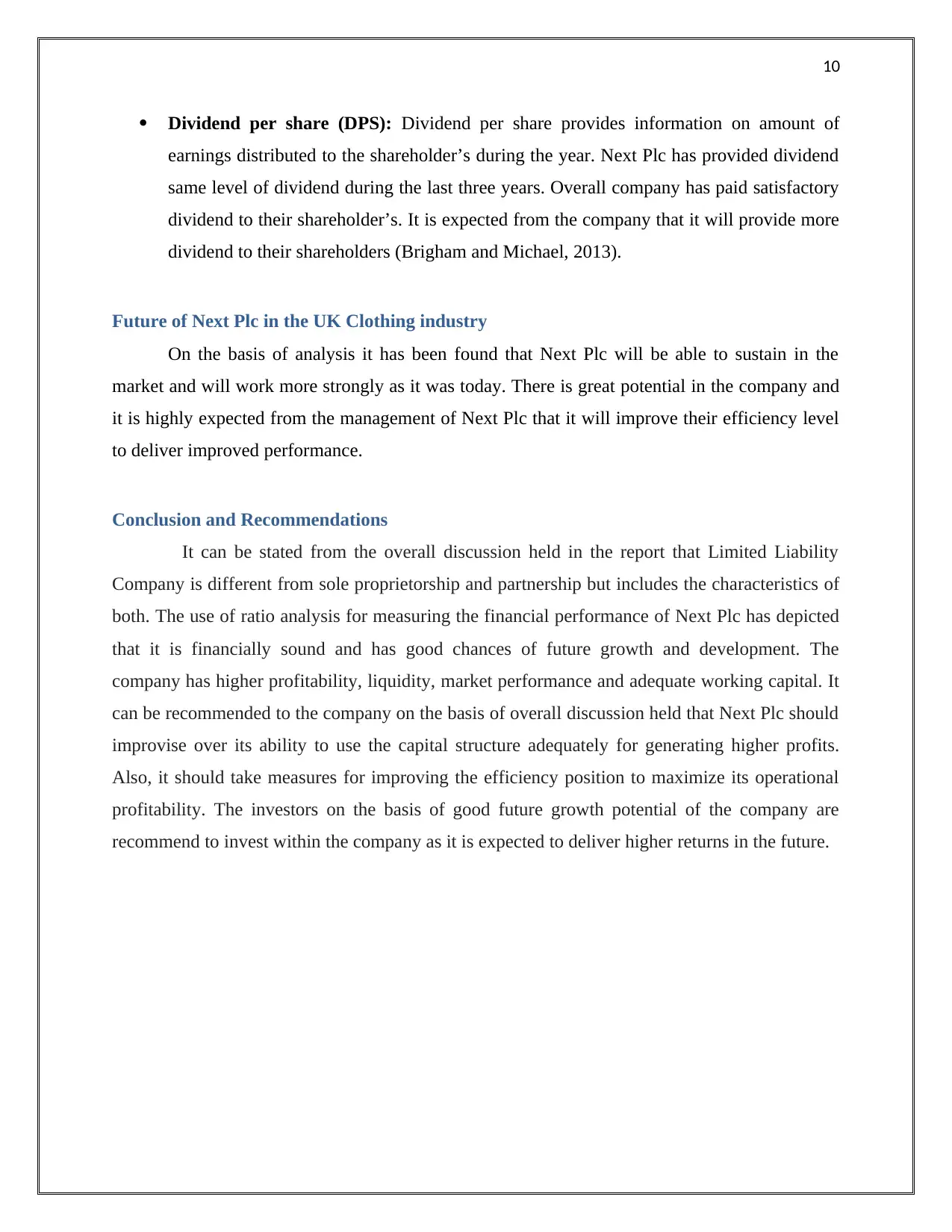
10
Dividend per share (DPS): Dividend per share provides information on amount of
earnings distributed to the shareholder’s during the year. Next Plc has provided dividend
same level of dividend during the last three years. Overall company has paid satisfactory
dividend to their shareholder’s. It is expected from the company that it will provide more
dividend to their shareholders (Brigham and Michael, 2013).
Future of Next Plc in the UK Clothing industry
On the basis of analysis it has been found that Next Plc will be able to sustain in the
market and will work more strongly as it was today. There is great potential in the company and
it is highly expected from the management of Next Plc that it will improve their efficiency level
to deliver improved performance.
Conclusion and Recommendations
It can be stated from the overall discussion held in the report that Limited Liability
Company is different from sole proprietorship and partnership but includes the characteristics of
both. The use of ratio analysis for measuring the financial performance of Next Plc has depicted
that it is financially sound and has good chances of future growth and development. The
company has higher profitability, liquidity, market performance and adequate working capital. It
can be recommended to the company on the basis of overall discussion held that Next Plc should
improvise over its ability to use the capital structure adequately for generating higher profits.
Also, it should take measures for improving the efficiency position to maximize its operational
profitability. The investors on the basis of good future growth potential of the company are
recommend to invest within the company as it is expected to deliver higher returns in the future.
Dividend per share (DPS): Dividend per share provides information on amount of
earnings distributed to the shareholder’s during the year. Next Plc has provided dividend
same level of dividend during the last three years. Overall company has paid satisfactory
dividend to their shareholder’s. It is expected from the company that it will provide more
dividend to their shareholders (Brigham and Michael, 2013).
Future of Next Plc in the UK Clothing industry
On the basis of analysis it has been found that Next Plc will be able to sustain in the
market and will work more strongly as it was today. There is great potential in the company and
it is highly expected from the management of Next Plc that it will improve their efficiency level
to deliver improved performance.
Conclusion and Recommendations
It can be stated from the overall discussion held in the report that Limited Liability
Company is different from sole proprietorship and partnership but includes the characteristics of
both. The use of ratio analysis for measuring the financial performance of Next Plc has depicted
that it is financially sound and has good chances of future growth and development. The
company has higher profitability, liquidity, market performance and adequate working capital. It
can be recommended to the company on the basis of overall discussion held that Next Plc should
improvise over its ability to use the capital structure adequately for generating higher profits.
Also, it should take measures for improving the efficiency position to maximize its operational
profitability. The investors on the basis of good future growth potential of the company are
recommend to invest within the company as it is expected to deliver higher returns in the future.
Paraphrase This Document
Need a fresh take? Get an instant paraphrase of this document with our AI Paraphraser
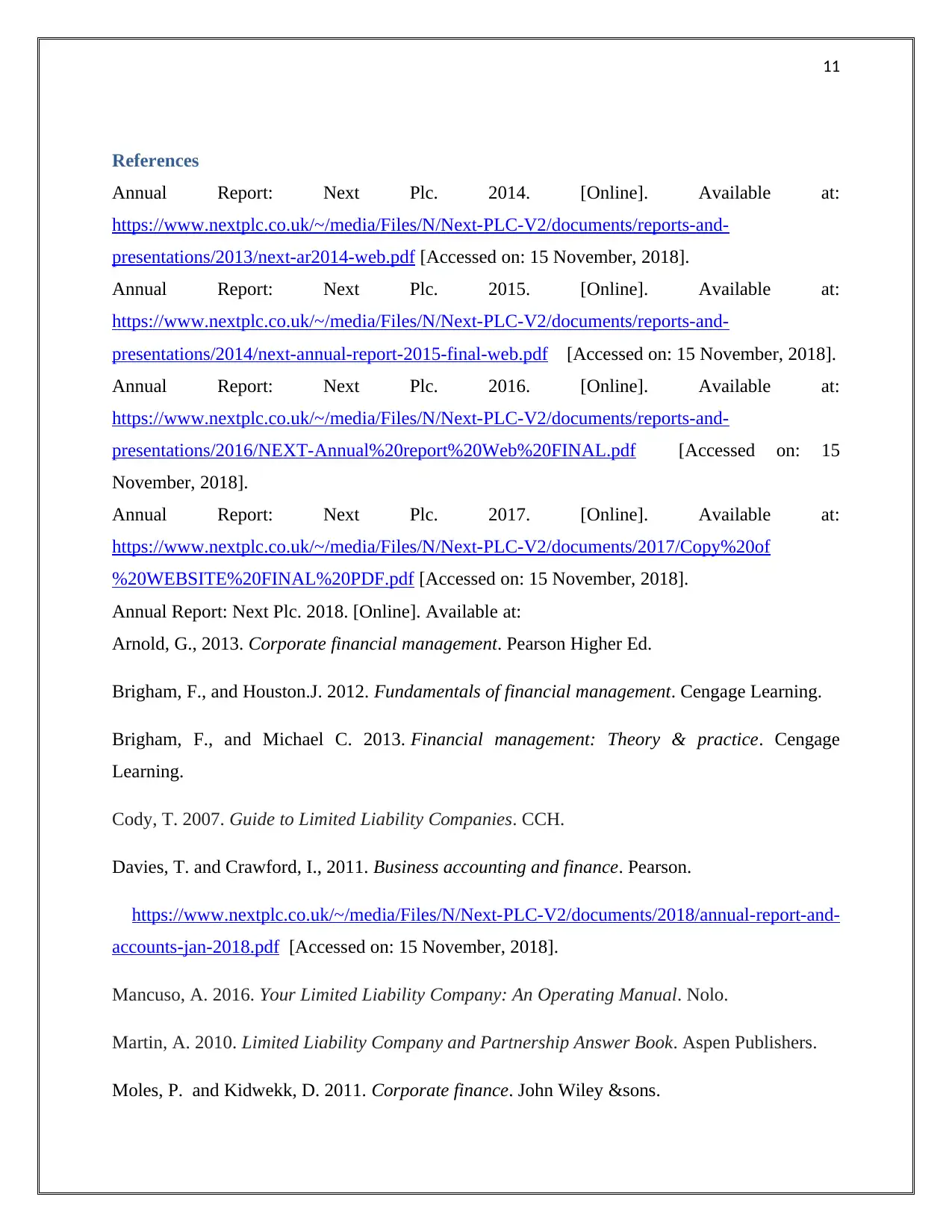
11
References
Annual Report: Next Plc. 2014. [Online]. Available at:
https://www.nextplc.co.uk/~/media/Files/N/Next-PLC-V2/documents/reports-and-
presentations/2013/next-ar2014-web.pdf [Accessed on: 15 November, 2018].
Annual Report: Next Plc. 2015. [Online]. Available at:
https://www.nextplc.co.uk/~/media/Files/N/Next-PLC-V2/documents/reports-and-
presentations/2014/next-annual-report-2015-final-web.pdf [Accessed on: 15 November, 2018].
Annual Report: Next Plc. 2016. [Online]. Available at:
https://www.nextplc.co.uk/~/media/Files/N/Next-PLC-V2/documents/reports-and-
presentations/2016/NEXT-Annual%20report%20Web%20FINAL.pdf [Accessed on: 15
November, 2018].
Annual Report: Next Plc. 2017. [Online]. Available at:
https://www.nextplc.co.uk/~/media/Files/N/Next-PLC-V2/documents/2017/Copy%20of
%20WEBSITE%20FINAL%20PDF.pdf [Accessed on: 15 November, 2018].
Annual Report: Next Plc. 2018. [Online]. Available at:
Arnold, G., 2013. Corporate financial management. Pearson Higher Ed.
Brigham, F., and Houston.J. 2012. Fundamentals of financial management. Cengage Learning.
Brigham, F., and Michael C. 2013. Financial management: Theory & practice. Cengage
Learning.
Cody, T. 2007. Guide to Limited Liability Companies. CCH.
Davies, T. and Crawford, I., 2011. Business accounting and finance. Pearson.
https://www.nextplc.co.uk/~/media/Files/N/Next-PLC-V2/documents/2018/annual-report-and-
accounts-jan-2018.pdf [Accessed on: 15 November, 2018].
Mancuso, A. 2016. Your Limited Liability Company: An Operating Manual. Nolo.
Martin, A. 2010. Limited Liability Company and Partnership Answer Book. Aspen Publishers.
Moles, P. and Kidwekk, D. 2011. Corporate finance. John Wiley &sons.
References
Annual Report: Next Plc. 2014. [Online]. Available at:
https://www.nextplc.co.uk/~/media/Files/N/Next-PLC-V2/documents/reports-and-
presentations/2013/next-ar2014-web.pdf [Accessed on: 15 November, 2018].
Annual Report: Next Plc. 2015. [Online]. Available at:
https://www.nextplc.co.uk/~/media/Files/N/Next-PLC-V2/documents/reports-and-
presentations/2014/next-annual-report-2015-final-web.pdf [Accessed on: 15 November, 2018].
Annual Report: Next Plc. 2016. [Online]. Available at:
https://www.nextplc.co.uk/~/media/Files/N/Next-PLC-V2/documents/reports-and-
presentations/2016/NEXT-Annual%20report%20Web%20FINAL.pdf [Accessed on: 15
November, 2018].
Annual Report: Next Plc. 2017. [Online]. Available at:
https://www.nextplc.co.uk/~/media/Files/N/Next-PLC-V2/documents/2017/Copy%20of
%20WEBSITE%20FINAL%20PDF.pdf [Accessed on: 15 November, 2018].
Annual Report: Next Plc. 2018. [Online]. Available at:
Arnold, G., 2013. Corporate financial management. Pearson Higher Ed.
Brigham, F., and Houston.J. 2012. Fundamentals of financial management. Cengage Learning.
Brigham, F., and Michael C. 2013. Financial management: Theory & practice. Cengage
Learning.
Cody, T. 2007. Guide to Limited Liability Companies. CCH.
Davies, T. and Crawford, I., 2011. Business accounting and finance. Pearson.
https://www.nextplc.co.uk/~/media/Files/N/Next-PLC-V2/documents/2018/annual-report-and-
accounts-jan-2018.pdf [Accessed on: 15 November, 2018].
Mancuso, A. 2016. Your Limited Liability Company: An Operating Manual. Nolo.
Martin, A. 2010. Limited Liability Company and Partnership Answer Book. Aspen Publishers.
Moles, P. and Kidwekk, D. 2011. Corporate finance. John Wiley &sons.
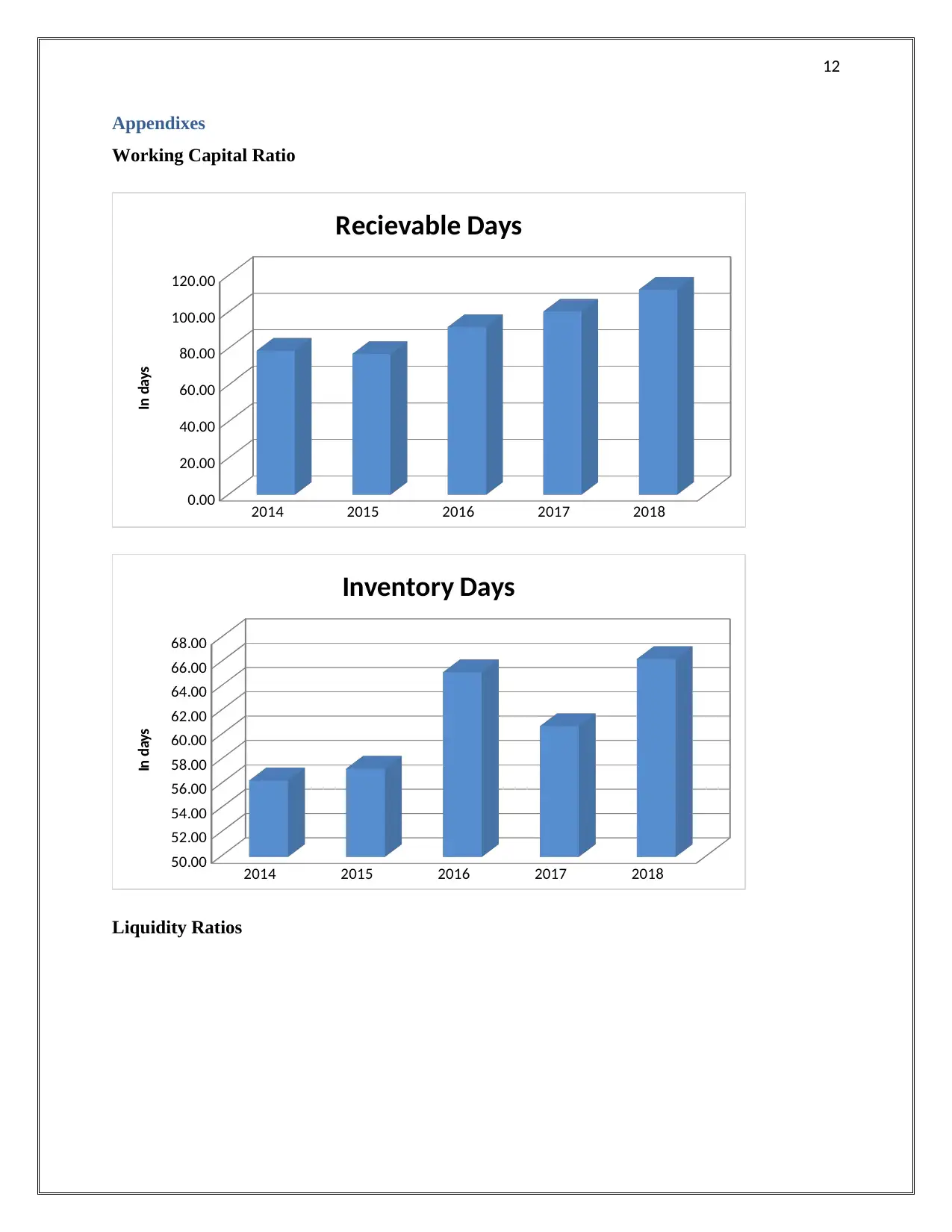
12
Appendixes
Working Capital Ratio
2014 2015 2016 2017 2018
0.00
20.00
40.00
60.00
80.00
100.00
120.00
Recievable Days
In days
2014 2015 2016 2017 2018
50.00
52.00
54.00
56.00
58.00
60.00
62.00
64.00
66.00
68.00
Inventory Days
In days
Liquidity Ratios
Appendixes
Working Capital Ratio
2014 2015 2016 2017 2018
0.00
20.00
40.00
60.00
80.00
100.00
120.00
Recievable Days
In days
2014 2015 2016 2017 2018
50.00
52.00
54.00
56.00
58.00
60.00
62.00
64.00
66.00
68.00
Inventory Days
In days
Liquidity Ratios
⊘ This is a preview!⊘
Do you want full access?
Subscribe today to unlock all pages.

Trusted by 1+ million students worldwide
1 out of 15
Related Documents
Your All-in-One AI-Powered Toolkit for Academic Success.
+13062052269
info@desklib.com
Available 24*7 on WhatsApp / Email
![[object Object]](/_next/static/media/star-bottom.7253800d.svg)
Unlock your academic potential
Copyright © 2020–2025 A2Z Services. All Rights Reserved. Developed and managed by ZUCOL.





